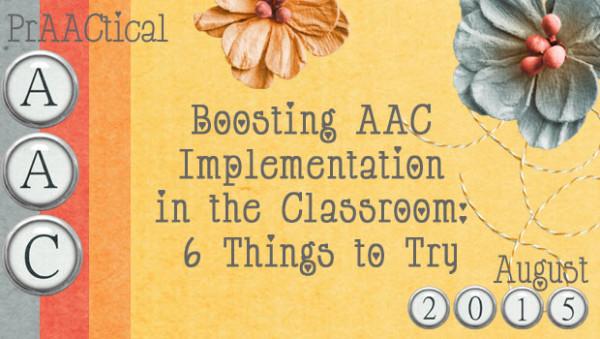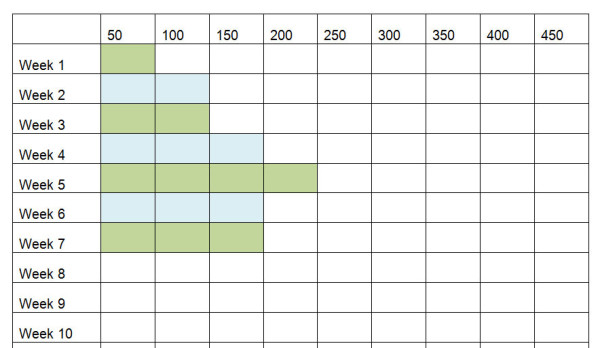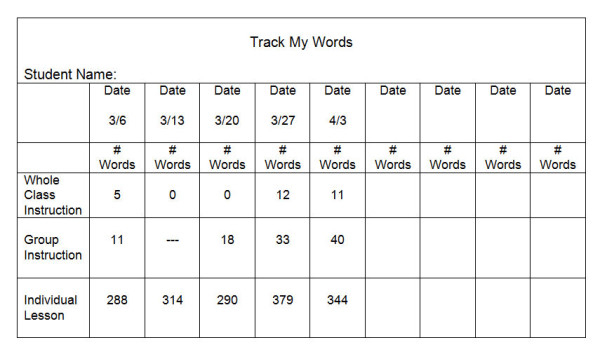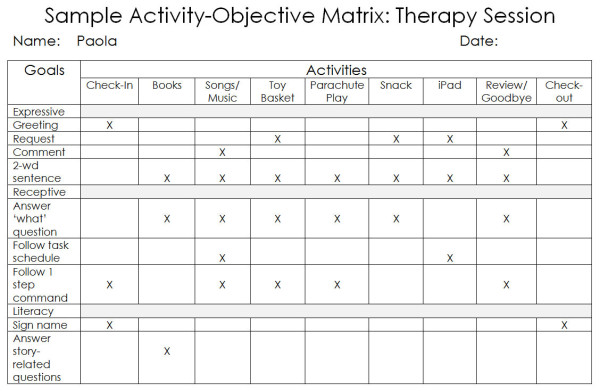Boosting AAC Implementation in the Classroom: 6 Things to Try

Classrooms are busy places, and sometimes the AAC gets lost in the hustle and bustle. If you’re interested in boosting AAC use during the school day, here are some things to try.
- Co-teach or teach a lesson: Think it’s easy to model AAC and elicit it at the same time you’re providing whole class or small group instruction? Try it. Better yet, make teaching a co-teaching a lesson in the classroom part of your regular service delivery schedule. It’s scary at first, but hang in there. You’ll gain valuable information about what it takes to make AAC successful under real-world conditions, and gain credibility with the rest of the team.
- Offer support: “What can I do to make it easier for classroom staff to implement the AAC strategies?” “Ms. Aide, how can I help you use the device more when you talk to Shayna?”
- Make the data available to everyone on the team: If you’re using an SGD or an AAC app, use the history and data collection features to gather information that you can share with the team. Making the data visible to everyone keeps us all accountable. Yes, it’s a two-sided coin. Honestly, there have been times where I cringed when graphing the data, but there is no doubt that holding myself accountable made for a better student outcome in the end.


- Recognize effort and achievement: It’s no easy thing to change our communication habits and that’s what needs to happen both to increase our use of aided language input and create more communication opportunities. Want to inspire others to reach a little further? Make it a habit to acknowledge the efforts that others are making and celebrate those successes.
- Model: When we adults use the AAC frequently, kids are likely to follow suit. Make it a goal to grow your skills in modeling AAC (aided language input) and actually doing it whenever possible. If it is important enough that you slow down and do this, you’ll be setting a great model for classroom staff, peers, and the target student. Conversely, if we can’t be bothered to use AAC when we speak to the learner, why would anyone else make the effort?

- Use a planning tool to help fill the gaps: AAC learners need a great deal of practice and planned opportunities for use of their AAC systems. Until they become more fluent in using their communication aids, it is helpful to plan out specific times during the day when AAC use is expected and supported. Tools like this Activity-Objective Matrix can help everyone stay on track with AAC implementation. They are easy to make, but you can download a packet of PrAACtical AAC versions here.

Do you have tried-and-true strategies for boosting AAC use in the classroom? We’d love to hear about them.
Filed under: PrAACtical Thinking
This post was written by Carole Zangari

8 Comments
During the school year, I read your page daily. It has made a significant difference in my ability to provide resources for my teachers and parents, as well as greatly expanding my knowledge base. Thank you for your commitment to making the world of AAC a better place!
Nadine, I feel so lucky to be teaming (if only virtually) with professionals like you. There is no doubt that we face considerable challenges in trying to support people who need AAC, but if we continue to support each other, I know we can do it. Thanks a million for taking the time to comment. It meant a lot to me to hear your perspective. 🙂
This year I’m sending an Ipad with LAMP Words for Life already on it for the aides and teacher to use. However, they are not familiar with the icons nor are they familiar with the language themselves. They cannot model what they do not know.
There is a list of core words we all use. Is there an equivalent of core “sentences” that educators use in Jr. High and High School lifeskills classroom? Planning to send “cheat sheets” with phrases so they can use the extra device I am loaning them.
AAC only seems to work for the student if it’s very simple for educators to use and understand. Thanks a lot for any thoughts, hints and insights.
Isabel, you’ve made a GREAT point and one that I could write a whole series of posts on. 🙂 In the meantime: What about giving them laminated paper copies of the main screens? That way, they can model on those and get familiar with the vocabulary, where it is located, etc. without taking the device away from the student. Also, don’t forget to use the IEP to your advantage. E.g., include this phrase in goals: Given aided language input, Student will; add training on AAC implementation for therapists, teachers, parents, aides, and other key stakeholders. AAC works for all kinds of learners, but the team has to be on board.
If you look up LAMP, they provide pre-made lessons for staff and students to learn the core language. Also, AAC Language lab has everything you need for LAMP, including all lessons for News2You. Its wonderful. I wish they had something like that for Proloquo.
Great suggestion, Tara! Thanks for that. 🙂
I can’t find News2You on LanguageLab. Do they still have them? Can you provide a link? I would be so excited if they do!
Never mind ! They spell it News-2-You with dashes!